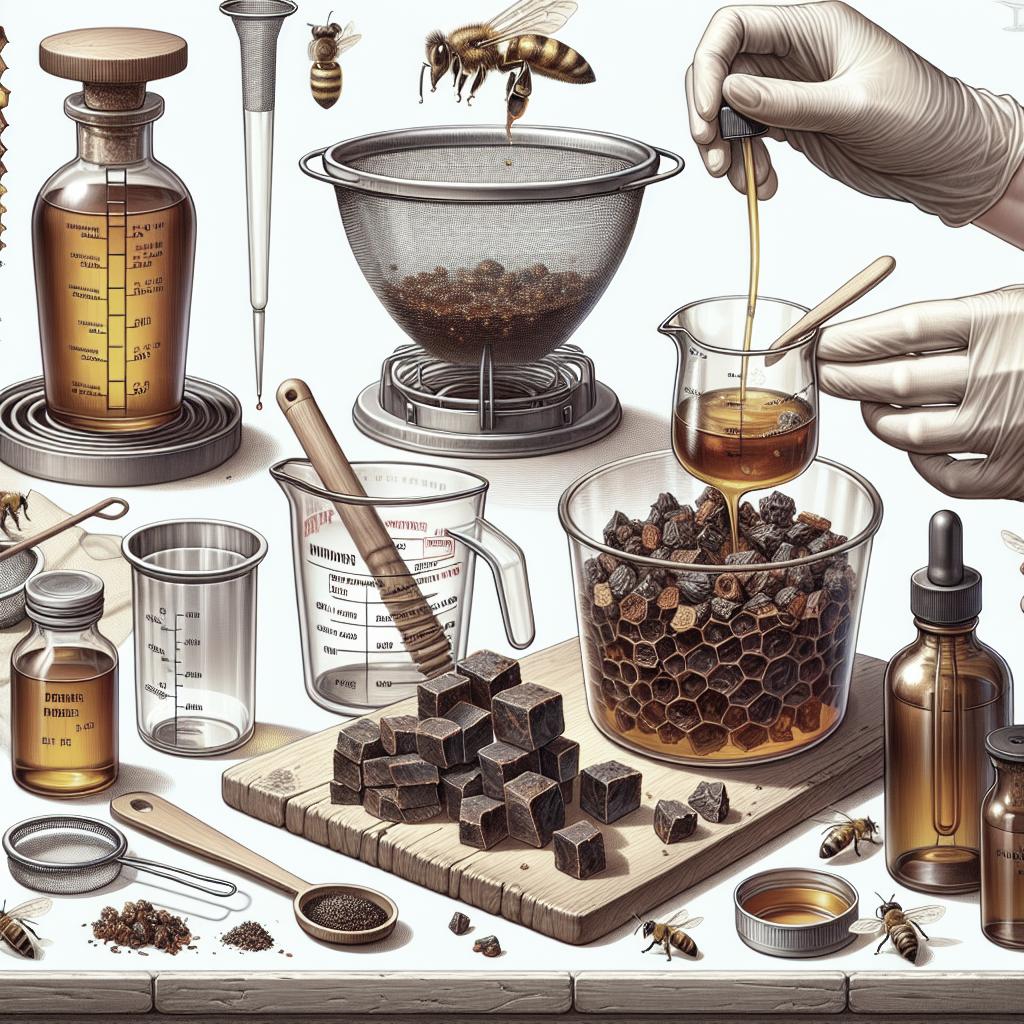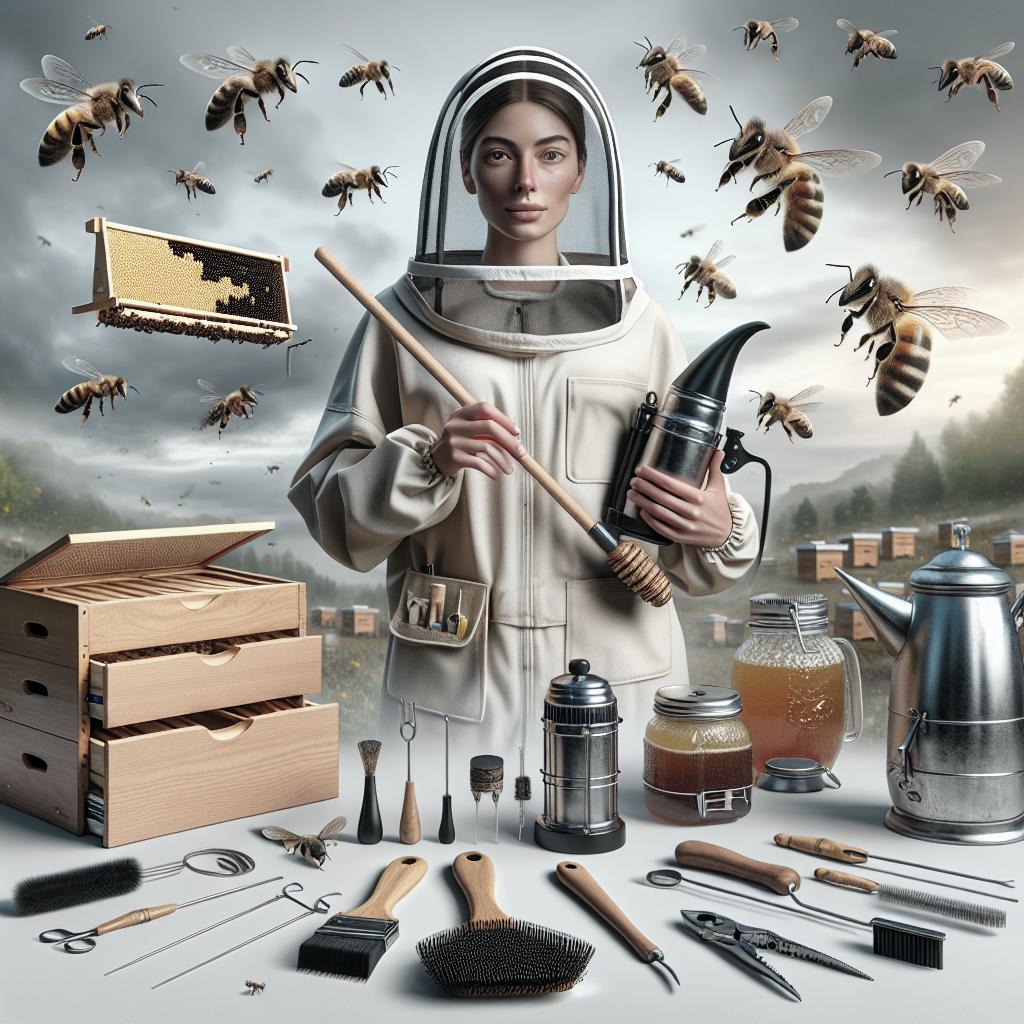How to Make Propolis Tincture
Propolis tincture is a wonderful natural remedy made by bees from substances they collect from plants. It’s rich in healing properties and used for various health issues, such as antibacterial and anti-inflammatory purposes. However, making your own propolis tincture can be a rewarding experience that allows you to control the ingredients and quality of the final product. This blog post will guide you through the necessary steps to create your own propolis tincture, along with additional useful beekeeping tips, safety cautions, and success stories. Let’s explore the fascinating world of beekeeping and homemade propolis tincture!
BEEKEEPING TIP: How to Make Syrup for Bees
When caring for bees, providing them with additional syrup feed during lean times is crucial for their survival. To make syrup for bees, a simple 1:1 ratio of water to white granulated sugar creates what’s known as a light syrup. Mix one part sugar with one part water and gently heat the mixture until all the sugar dissolves. It’s essential that the syrup is completely clear before offering it to the bees, ensuring no granules remain undissolved.
In harsher weather conditions or during winter, bees may require a heavier syrup, which is a 2:1 sugar-to-water ratio. This thicker syrup helps bees store extra energy more efficiently. It’s always important to remember that the syrup should not be boiled, as overheated mixtures can produce compounds harmful to bees.
Cautions
Dealing with propolis and other bee-related products requires some caution. First and foremost, it’s crucial to ensure that anyone using home-made propolis tincture is not allergic to bee products. An allergic reaction can be severe, so consultation with a healthcare professional is recommended if there are any concerns.
Additionally, when making propolis tincture, using high-proof alcohol can pose safety risks if not handled properly. Ensure you work in a well-ventilated area and avoid open flames or heat sources that could ignite the alcohol vapors. Wear gloves if necessary to protect your skin from possible irritants present in the raw propolis.
Hanna’s Bees Win at Irish Made Awards 2024
In exciting news from the beekeeping world, Hanna’s Bees, a small family-run company, has recently been awarded at the prestigious Irish Made Awards 2024. Celebrated for their commitment to quality and sustainability, Hanna’s Bees offers a range of bee products crafted with care and expertise. Their success underscores the growing appreciation for beekeeping and natural bee products, as more consumers seek sustainable and ethical choices.
Hanna’s Bees’ achievement shines a spotlight on the dedication required in the art of beekeeping and the creation of products like propolis tincture. As they continue to grow and innovate, they inspire budding beekeepers to explore this fulfilling and environmentally significant occupation. Their success story encourages individuals to delve deeper into the practices of ethical beekeeping and explore their creative potential.
How to Feed Bees in Autumn – Beginner’s Guide
Feeding bees in autumn is crucial to prepare them for the long winter months ahead. A strong hive must have enough stored honey and supplemental feeding to survive the colder season. Begin by assessing the hive’s current honey reserves – a hive should ideally have 20-30 pounds of stored honey going into winter.
If bees fall short of this reserve, supplementary feeding with syrup is necessary. Use a heavier syrup (2:1 sugar to water) during the autumn months to help them build up their honey stores. Feeding is typically done using a hive top feeder or entrance feeder. Be mindful of the local weather, as syrup can ferment, posing additional risks to the hive’s health.
Soft Set Honey – What is it & How is it Made?
Soft set honey is a delightful spreadable honey variation, often preferred for its smooth consistency and ease of use, particularly in spreads and baking. This type of honey undergoes a natural process of controlled crystallization, providing a texture different from its liquid counterpart while preserving its rich flavor and natural sweetness.
To make soft set honey, start by mixing a small amount of already crystallized honey into liquid honey. This seed honey helps initiate consistent crystallization throughout the batch. Then, store the mixture at a cool place, ideally around 14°C (57°F), to encourage uniform and fine grain formation. Stirring occasionally can also improve texture quality. Soft set honey showcases the versatility and craft behind honey processing, making it a popular choice among honey lovers.
To make your own propolis, follow these instructions:
Making your own propolis tincture is an accessible process, using simple ingredients and equipment. Begin by gathering raw propolis from your beehive. Propolis is often found along frame edges and other hive surfaces, displaying a sticky, resin-like appearance. Gather approximately 100 grams of raw propolis for a small batch.
Next, prepare the alcohol base. Use food-grade, high-proof alcohol like vodka or ethanol. In a glass jar, combine the collected propolis with the alcohol at a 1:2 ratio (by weight), ensuring the alcohol fully submerges the propolis pieces. Seal the jar and place it in a dark, cool environment for about two weeks, shaking it daily to facilitate the extraction process.
After two weeks, strain the tincture through a fine mesh or cheesecloth into another clean glass bottle, removing any solid pieces. Your freshly made propolis tincture is now ready for use, stored at room temperature away from direct sunlight. Utilize it by using a few drops per dose as needed for its health benefits.
Final Thoughts
| Section | Summary |
|---|---|
| Beekeeping Tip | Learn how to make syrup for bees using simple sugar and water mixtures for various seasons. |
| Cautions | Important safety tips and considerations while handling propolis and alcohol for tincture production. |
| Hanna’s Bees Award | Celebrating the success of Hanna’s Bees at Irish Made Awards 2024 and their impact on beekeeping. |
| Feeding Bees in Autumn | Guide to providing supplemental feeding to bees during autumn to ensure winter survival. |
| Soft Set Honey | Exploring the processes behind the creation and benefits of soft set honey. |
| Making Propolis Tincture | Step-by-step instructions on making your own propolis tincture using raw propolis and alcohol. |


